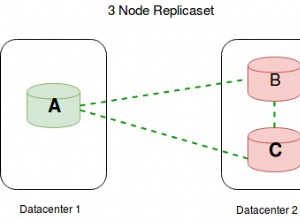Finché i tuoi dati hanno letture di sensori e tag univoche per documento, che fino ad oggi sembra ciò che hai presentato, semplicemente non hai bisogno di $unwind
affatto.
In effetti, tutto ciò di cui hai veramente bisogno è un singolo $group
:
db.endpoints.aggregate([
// In reality you would $match to limit the selection of documents
{ "$match": {
"DateTime": { "$gte": new Date("2018-05-01"), "$lt": new Date("2018-06-01") }
}},
{ "$group": {
"_id": "$EndpointId",
"FirstActivity" : { "$min" : "$DateTime" },
"LastActivity" : { "$max" : "$DateTime" },
"RequestCount": { "$sum": 1 },
"TagCount": {
"$sum": {
"$size": { "$setUnion": ["$Tags.Uid",[]] }
}
},
"SensorCount": {
"$sum": {
"$sum": {
"$map": {
"input": { "$setUnion": ["$Tags.Uid",[]] },
"as": "tag",
"in": {
"$size": {
"$reduce": {
"input": {
"$filter": {
"input": {
"$map": {
"input": "$Tags",
"in": {
"Uid": "$$this.Uid",
"Type": "$$this.Sensors.Type"
}
}
},
"cond": { "$eq": [ "$$this.Uid", "$$tag" ] }
}
},
"initialValue": [],
"in": { "$setUnion": [ "$$value", "$$this.Type" ] }
}
}
}
}
}
}
}
}}
])
Oppure, se hai effettivamente bisogno di accumulare quei valori "unici" di "Sensori" e "Tag" da documenti diversi, allora hai ancora bisogno dell'iniziale $unwind
dichiarazioni per ottenere il raggruppamento corretto, ma non tanto quanto quello che hai attualmente:
db.endpoints.aggregate([
// In reality you would $match to limit the selection of documents
{ "$match": {
"DateTime": { "$gte": new Date("2018-05-01"), "$lt": new Date("2018-06-01") }
}},
{ "$unwind": "$Tags" },
{ "$unwind": "$Tags.Sensors" },
{ "$group": {
"_id": {
"EndpointId": "$EndpointId",
"Uid": "$Tags.Uid",
"Type": "$Tags.Sensors.Type"
},
"FirstActivity": { "$min": "$DateTime" },
"LastActivity": { "$max": "$DateTime" },
"RequestCount": { "$addToSet": "$_id" }
}},
{ "$group": {
"_id": {
"EndpointId": "$_id.EndpointId",
"Uid": "$_id.Uid",
},
"FirstActivity": { "$min": "$FirstActivity" },
"LastActivity": { "$max": "$LastActivity" },
"count": { "$sum": 1 },
"RequestCount": { "$addToSet": "$RequestCount" }
}},
{ "$group": {
"_id": "$_id.EndpointId",
"FirstActivity": { "$min": "$FirstActivity" },
"LastActivity": { "$max": "$LastActivity" },
"TagCount": { "$sum": 1 },
"SensorCount": { "$sum": "$count" },
"RequestCount": { "$addToSet": "$RequestCount" }
}},
{ "$addFields": {
"RequestCount": {
"$size": {
"$reduce": {
"input": {
"$reduce": {
"input": "$RequestCount",
"initialValue": [],
"in": { "$setUnion": [ "$$value", "$$this" ] }
}
},
"initialValue": [],
"in": { "$setUnion": [ "$$value", "$$this" ] }
}
}
}
}}
],{ "allowDiskUse": true })
E da MongoDB 4.0 puoi usare $toString
su ObjectId all'interno di _id e unisci semplicemente le chiavi univoche per quelle al fine di mantenere il RequestCount utilizzando $mergeObjects
. Questo è più pulito e un po' più scalabile rispetto a spingere il contenuto di array nidificati e appiattirlo
db.endpoints.aggregate([
// In reality you would $match to limit the selection of documents
{ "$match": {
"DateTime": { "$gte": new Date("2018-05-01"), "$lt": new Date("2018-06-01") }
}},
{ "$unwind": "$Tags" },
{ "$unwind": "$Tags.Sensors" },
{ "$group": {
"_id": {
"EndpointId": "$EndpointId",
"Uid": "$Tags.Uid",
"Type": "$Tags.Sensors.Type"
},
"FirstActivity": { "$min": "$DateTime" },
"LastActivity": { "$max": "$DateTime" },
"RequestCount": {
"$mergeObjects": {
"$arrayToObject": [[{ "k": { "$toString": "$_id" }, "v": 1 }]]
}
}
}},
{ "$group": {
"_id": {
"EndpointId": "$_id.EndpointId",
"Uid": "$_id.Uid",
},
"FirstActivity": { "$min": "$FirstActivity" },
"LastActivity": { "$max": "$LastActivity" },
"count": { "$sum": 1 },
"RequestCount": { "$mergeObjects": "$RequestCount" }
}},
{ "$group": {
"_id": "$_id.EndpointId",
"FirstActivity": { "$min": "$FirstActivity" },
"LastActivity": { "$max": "$LastActivity" },
"TagCount": { "$sum": 1 },
"SensorCount": { "$sum": "$count" },
"RequestCount": { "$mergeObjects": "$RequestCount" }
}},
{ "$addFields": {
"RequestCount": {
"$size": {
"$objectToArray": "$RequestCount"
}
}
}}
],{ "allowDiskUse": true })
Entrambi i moduli restituiscono gli stessi dati, sebbene l'ordine delle chiavi nel risultato possa variare:
{
"_id" : "89799bcc-e86f-4c8a-b340-8b5ed53caf83",
"FirstActivity" : ISODate("2018-05-06T19:05:02.666Z"),
"LastActivity" : ISODate("2018-05-06T19:05:02.666Z"),
"RequestCount" : 2,
"TagCount" : 4,
"SensorCount" : 16
}
Il risultato è ottenuto da questi documenti di esempio che hai fornito originariamente come fonte di esempio nella la domanda originale sull'argomento :
{
"_id" : ObjectId("5aef51dfaf42ea1b70d0c4db"),
"EndpointId" : "89799bcc-e86f-4c8a-b340-8b5ed53caf83",
"DateTime" : ISODate("2018-05-06T19:05:02.666Z"),
"Url" : "test",
"Tags" : [
{
"Uid" : "C1:3D:CA:D4:45:11",
"Type" : 1,
"DateTime" : ISODate("2018-05-06T19:05:02.666Z"),
"Sensors" : [
{
"Type" : 1,
"Value" : NumberDecimal("-95")
},
{
"Type" : 2,
"Value" : NumberDecimal("-59")
},
{
"Type" : 3,
"Value" : NumberDecimal("11.029802536740132")
},
{
"Type" : 4,
"Value" : NumberDecimal("27.25")
},
{
"Type" : 6,
"Value" : NumberDecimal("2924")
}
]
},
{
"Uid" : "C1:3D:CA:D4:45:11",
"Type" : 1,
"DateTime" : ISODate("2018-05-06T19:05:02.666Z"),
"Sensors" : [
{
"Type" : 1,
"Value" : NumberDecimal("-95")
},
{
"Type" : 2,
"Value" : NumberDecimal("-59")
},
{
"Type" : 3,
"Value" : NumberDecimal("11.413037961112279")
},
{
"Type" : 4,
"Value" : NumberDecimal("27.25")
},
{
"Type" : 6,
"Value" : NumberDecimal("2924")
}
]
},
{
"Uid" : "E5:FA:2A:35:AF:DD",
"Type" : 1,
"DateTime" : ISODate("2018-05-06T19:05:02.666Z"),
"Sensors" : [
{
"Type" : 1,
"Value" : NumberDecimal("-97")
},
{
"Type" : 2,
"Value" : NumberDecimal("-58")
},
{
"Type" : 3,
"Value" : NumberDecimal("10.171658037099185")
}
]
}
]
}
/* 2 */
{
"_id" : ObjectId("5aef51e0af42ea1b70d0c4dc"),
"EndpointId" : "89799bcc-e86f-4c8a-b340-8b5ed53caf83",
"Url" : "test",
"Tags" : [
{
"Uid" : "E2:02:00:18:DA:40",
"Type" : 1,
"DateTime" : ISODate("2018-05-06T19:05:04.574Z"),
"Sensors" : [
{
"Type" : 1,
"Value" : NumberDecimal("-98")
},
{
"Type" : 2,
"Value" : NumberDecimal("-65")
},
{
"Type" : 3,
"Value" : NumberDecimal("7.845424441900629")
},
{
"Type" : 4,
"Value" : NumberDecimal("0.0")
},
{
"Type" : 6,
"Value" : NumberDecimal("3012")
}
]
},
{
"Uid" : "12:3B:6A:1A:B7:F9",
"Type" : 1,
"DateTime" : ISODate("2018-05-06T19:05:04.574Z"),
"Sensors" : [
{
"Type" : 1,
"Value" : NumberDecimal("-95")
},
{
"Type" : 2,
"Value" : NumberDecimal("-59")
},
{
"Type" : 3,
"Value" : NumberDecimal("12.939770381907275")
}
]
}
]
}
La conclusione è che puoi utilizzare il primo modulo fornito qui che si accumulerà "all'interno di ciascun documento" e quindi "accumulerà per endpoint" all'interno di una singola fase ed è il più ottimale, oppure in realtà è necessario identificare cose come il "Uid" sui tag o sul "Type" sul sensore in cui tali valori si verificano più di una volta su qualsiasi combinazione di documenti raggruppati in base all'endpoint.
I dati di esempio forniti fino ad oggi mostrano solo che questi valori sono "unici all'interno di ogni documento", quindi la prima forma data sarebbe la più ottimale se questo fosse il caso per tutti i dati rimanenti.
Nel caso in cui non lo sia, l'unico modo per avvicinarsi è lo "svolgimento" dei due array nidificati per "aggregare i dettagli tra i documenti". Puoi limitare l'intervallo di date o altri criteri poiché la maggior parte delle "query" in genere hanno dei limiti e in realtà non funzionano sui dati "interi" della raccolta, ma il fatto principale rimane che gli array verrebbero "svolti" creando essenzialmente una copia del documento per ogni membro dell'array.
Il punto sull'ottimizzazione significa che devi farlo solo "due volte" poiché ci sono solo due array. Eseguire $group
a $unwind
a $group
è sempre un segno sicuro che stai facendo qualcosa di veramente sbagliato. Una volta che hai "smontato qualcosa", dovresti solo "rimontarlo" una volta . In una serie di passaggi graduali, come mostrato qui c'è il una volta approccio che ottimizza.
Al di fuori dell'ambito della tua domanda rimane ancora:
- Aggiungere altri vincoli realistici alla query per ridurre i documenti elaborati, magari farlo anche in "batch" e combinare i risultati
- Aggiungi il
allowDiskUseopzione alla pipeline per consentire l'utilizzo dell'archiviazione temporanea. ( effettivamente dimostrato sui comandi ) - Considera che gli "array nidificati" non sono probabilmente il miglior metodo di archiviazione per l'analisi che desideri eseguire. È sempre più efficiente quando sai che devi
$unwindper scrivere semplicemente i dati in quel modulo "svolto" direttamente in una raccolta.




